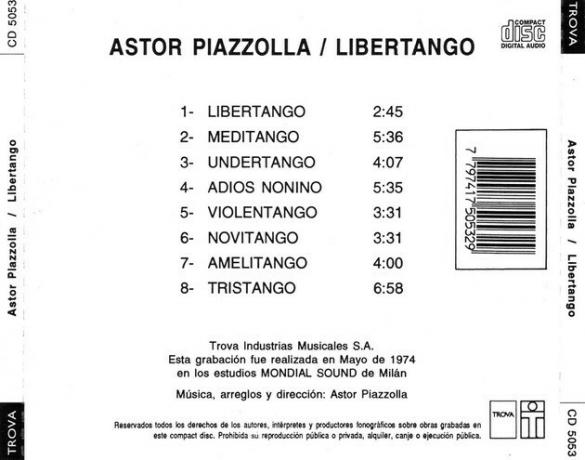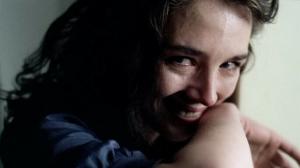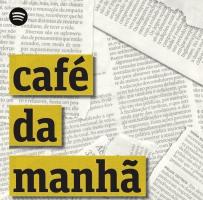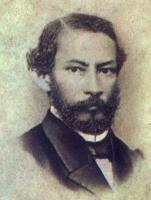Libertango by Astor Piazzolla: history and analysis
The song Libertango by Astor Piazzolla was published in 1974 on a self-titled album. This composer, born in 1921 and died in 1992, was responsible for renewing the tango genre in Buenos Aires, which earned him more than one criticism from purists.
Libertango, from its title, expresses the will of Piazzolla to open the compass of tradition so that the sonorous echoes of a society in transformation as was the second half of the twentieth century. The title is, in itself, an acclaim for musical freedom and creativity.
Piazzolla certainly did not have it easy. The break that his style supposed was very badly received by the representatives of the tango tradition. He went on to earn the epithet "killer of tango". The rejection was not limited to a disqualifying opinion.
Some radio stations objected to broadcasting his music and the record companies were afraid to release it due to the vehement criticism of the "sacred cows" of traditional tango. Not that he didn't have fans in his homeland, but his adversaries made a lot of noise against him.
Piazzolla did not give in to his creative spirit. After years of constant work, in which he had won the complicity of the most receptive public, and after his consecration in Europe with the success of Libertango, Piazzolla finally succeeded in getting the Argentine critics to assess his proposal in a resolute way. Thus he became an icon of tango.
Song description Libertango
The topic Libertango is the introduction of the album and it takes place in just 2:45 minutes. The participation of elements such as the string section, the drums or the electric guitar, unacceptable in the conception of the traditional tango, are part of the orchestra that accompanies the theme.
With these elements, Piazzolla reaffirms its style mark by insisting on one of the most obvious ruptures: the format. This would not be the first time that Piazzolla would play with the musical format, but this time his conception would have reached greater maturity.
Harmony would be another of Piazzolla's novel elements, who introduces his own harmonic relationships of jazz and with it, renews the auditory sensation of the genre, whose tradition was based on the harmony classical.
From the beginning of the topic Libertango, the bandoneon makes the entrance of it, marking the pulse and energy of the piece. Thus, Piazzolla exhibits the first motif or theme A, accompanied by the electric bass and the percussion. Little by little, the elements of the orchestra are added, presenting in the second motif or theme B on the same harmonic base, which allows the bandoneon to continue playing the first motive in a parallel.
At the end of this section, the bandoneon stands out to offer its melodic splendor and present theme C on a different harmonic development. At the end of this exhibition, the orchestra returns to the first part and the theme ends with a fade out or cast.
We leave you here the link to listen to the song in its original version:
You can read also The 10 best compositions of Astor Piazzolla.
Song versions Libertango
The way it was conceived Libertango he made it an ideal subject for freedom of improvisation and interpretation. Astor Piazzolla himself made more than one version of it. In fact, in 1977, Piazzolla and his band, in a performance for French television, presented a version of Libertango with a duration of more than 5 minutes. You can listen to it in the following link.
The piece, of an instrumental nature, would attract the attention of the audience and the musicians in such a way that many versions, both instrumental and sung, would soon appear.
Libertango and the text by Horacio Ferrer
Horacio Ferrer, who worked with Piazzolla as lyricist for his most popular songs, such as Ballad for a crazy or Chiquilín de Bachín, wrote a text to be recited on Libertango. The topic? It could not be other than the Liberty. We transcribe the text and leave the link to listen to a version that includes it.
My freedom loves me and I give my whole being to it.
My freedom unlocks the jail of my bones.
My freedom is offended if I am happy with fear.
My naked freedom makes me the perfect love.My freedom insists on what I do not dare.
My freedom wants me with what I'm wearing.
My freedom absolves me if I ever lose it
for things in life that I can't understand.My freedom does not count how old I am,
unwavering shepherd of my eternal dreams.
My freedom leaves me and I am a poor specter,
my freedom calls me and in wings suits I return.My freedom understands that I feel imprisoned
of my mistakes without regret.
My freedom would like the star without a holiday
and the captive atom, to be free, what a mystery!Be free. Already in her womb my mother told me
"Being free is not bought, nor is it a gift or favor."
I live off the beautiful secret of this orgy:
if dust I went and to dust I will go, I am dust of joy
and in milk of my soul I impregnate my freedom in flower.As a child I adored her, wishing for her I grew up,
my freedom, woman of time and light,
I love her until the pain and until the loneliness.My freedom dreams of my dead loved ones,
my freedom adores those I love in life.
My freedom tells me, from time to time, inside,
that we are as happy as we want to be.My freedom knows the one who killed and the raven
that suffocates and torments the freedom of the good.
My freedom is infested with hypocrites and fools,
my freedom stays up late with saints and bohemians.My freedom is tango wide open
and it's blues and it's cueca and choro, danzón and ballads.
My freedom is tango, minstrel from town to town,
and it's murga and symphony and it's choir in black and whiteMy freedom is tango that dances in ten thousand ports
and it's rock, malambo and salmo and it's opera and flamenco.
My libertango is free, poet and street,
as old as the world, as simple as a creed.As a child I adored her, wishing for her I grew up,
my freedom, woman of time and light,
I love her until the pain and until the loneliness.
Instrumental version of Aydar Gaynullin with the Berliner Philharmoniker
Among the instrumental versions, we can mention the outstanding performance of accordionist Aydar Gaynullin with the Berliner Philharmoniker recorded in 2014. Along with him are Artyom Dervoed on guitar and Sergey Shamov on cajon, under the direction of David Robert Coleman.
Instrumental version of Yo Yo Ma
Yo Yo Ma, the famous musician of Chinese origin, also made an adaptation of Libertango to the cello. It was released in 1997.
Grace Jones version
Among the sung versions we can mention that of the Jamaican Grace Jones, also known under the title Strange or I've Seen That Face Before, whose launch was yours in 1981.
Version of María Rivas
The Venezuelan María Rivas will launch, around 2009, her version of Libertango under the production of Miguel Chacón, and included it in an album called Pepiada Queen.
About the disk Libertango
Libertango It was the album that gave Piazzolla the entrance to the European market, at which point some things would change for the artist, especially regarding its reception in Argentina. The disc LibertangoAs we have announced, it was recorded in Milan in 1974, the same year it was launched on the market.
It is made up of a repertoire of eight songs, arranged in the following order (see the image):

Produced by Aldo Pagani, the album Libertango had the participation of the following musicians:
- Hammond piano and organ: Felice da Via;
- Hammond and marimba: Gianni Zilioli;
- Electric guitar: Filippo Dacco;
- Bass: Pino Presti;
- Flutes: Marlene Kessik, Hugo Heredia and Gianni Bedori;
- First violin: Umberto Benedetti Michelangeli;
- First viola: Elsa Parravicini;
- First cello: Paolo Salvi.
- Drums and percussion: Tullio de Piscopo;
- Timpani and percussion: Andrea Poggi (timpani, percussion).



